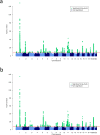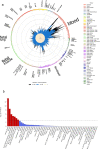European and multi-ancestry genome-wide association meta-analysis of atopic dermatitis highlights importance of systemic immune regulation
- PMID: 37794016
- PMCID: PMC10550990
- DOI: 10.1038/s41467-023-41180-2
European and multi-ancestry genome-wide association meta-analysis of atopic dermatitis highlights importance of systemic immune regulation
Abstract
Atopic dermatitis (AD) is a common inflammatory skin condition and prior genome-wide association studies (GWAS) have identified 71 associated loci. In the current study we conducted the largest AD GWAS to date (discovery N = 1,086,394, replication N = 3,604,027), combining previously reported cohorts with additional available data. We identified 81 loci (29 novel) in the European-only analysis (which all replicated in a separate European analysis) and 10 additional loci in the multi-ancestry analysis (3 novel). Eight variants from the multi-ancestry analysis replicated in at least one of the populations tested (European, Latino or African), while two may be specific to individuals of Japanese ancestry. AD loci showed enrichment for DNAse I hypersensitivity and eQTL associations in blood. At each locus we prioritised candidate genes by integrating multi-omic data. The implicated genes are predominantly in immune pathways of relevance to atopic inflammation and some offer drug repurposing opportunities.
© 2023. Springer Nature Limited.
Conflict of interest statement
K.M.G. has received reimbursement for speaking at conferences sponsored by companies selling nutritional products, and is part of an academic consortium that has received research funding from Abbott Nutrition, Nestec, BenevolentAI Bio Ltd. and Danone. C.G., S.S.S., and 23andMe Research Team are employed by and hold stock or stock options in 23andMe, Inc. The remaining authors declare no competing interests.
Figures




References
-
- Weidinger S, et al. Atopic dermatitis. The Lancet. 2016;387:1109–1122. - PubMed
Publication types
MeSH terms
Grants and funding
- MC_PC_19009/MRC_/Medical Research Council/United Kingdom
- MC_UU_00011/4/MRC_/Medical Research Council/United Kingdom
- MC_UU_00032/1/MRC_/Medical Research Council/United Kingdom
- WT_/Wellcome Trust/United Kingdom
- MR/S019669/1/MRC_/Medical Research Council/United Kingdom
- MC_UU_00011/1/MRC_/Medical Research Council/United Kingdom
- MR/J012165/1/MRC_/Medical Research Council/United Kingdom
- R01 HL118455/HL/NHLBI NIH HHS/United States
- MC_PC_15018/MRC_/Medical Research Council/United Kingdom
- G9815508/MRC_/Medical Research Council/United Kingdom
- 220875/Z/20/Z/WT_/Wellcome Trust/United Kingdom
LinkOut - more resources
Full Text Sources

